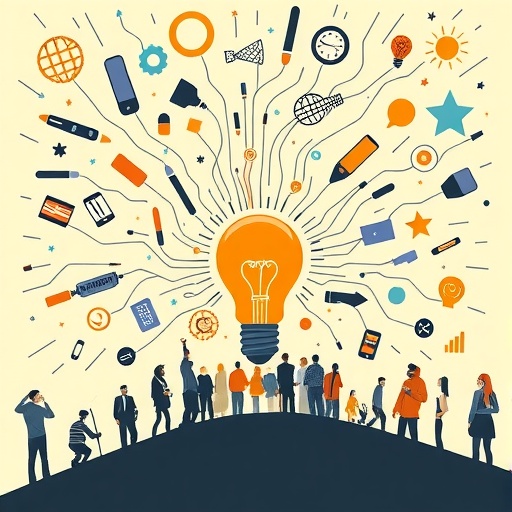In the vast and often unpredictable ecosystem of the internet, ideas, beliefs, jokes, and memes erupt and recede with a mystifying dynamism. Some content catches swiftly like wildfire, spreading far and wide, while others fade harmlessly into the digital ether. What determines whether an idea flares into a viral sensation or quietly extinguishes remains a pivotal question for researchers studying information diffusion and social contagion. A recent study published in Physical Review Letters spearheaded by experts from the University of Vermont and the Santa Fe Institute illuminates this phenomenon by proposing a groundbreaking mathematical model that captures not only the spread but also the transformation of ideas as they propagate.
Traditional models of contagion, grounded in branching process theory, portray the transmission of information or diseases as a static sequence: a person infected passes it along unchanged to a set number of others, who themselves pass it further, maintaining a consistent intensity or virality throughout the chain. This approach conceptualizes the spread of content as a tree-like cascade with fixed properties, offering useful but limited predictions. The novel approach introduced by this team disrupts that notion by factoring in real-time evolution—each step in the cascade can amplify or diminish the strength of what is spreading, fundamentally altering its trajectory and eventual reach.
The inspiration behind this fresh perspective draws heavily from the natural dynamics of forest fires. As Sid Redner, co-author and professor at the Santa Fe Institute, explains, the fortitude of a fire depends on the density and type of the terrain; it can either flare vigorously through thick woods or falter in sparseness. Applying this analogy to the transmission of information, jokes, or beliefs, the strength of the spread can also fluctuate depending on the environment it encounters, such as the receptivity of an audience or the prevailing social context.
At the core of the model lies a deceptively simple principle: when an idea or product spreads, it has a probabilistic chance not only to pass on but also to change in quality or intensity. If the content weakens below a threshold or reaches an indifferent audience, it peters out. Conversely, even a slight enhancement in its appeal or potency increases the likelihood of further spread, enabling the cascade to snowball into large-scale viral phenomena. This mechanism imbues the model with a self-reinforcing characteristic that mimics the erratic, yet deeply human, nature of information dissemination.
The implications of this approach are profound. Unlike classical epidemic or rumor-spreading models that often require the system to be near a finely tuned critical point to replicate real-world statistical features—such as long-tailed distributions of outbreak sizes—the self-reinforcing cascade model naturally produces these complex patterns. It effectively explains why most information cascades remain modest, while a few achieve explosive virality, without relying on stringent assumptions about the system’s initial state. This emergent variability mirrors the statistical fingerprints of social media virality and epidemic outbreaks alike.
Laurent Hébert-Dufresne, the lead author and computer scientist affiliated with both the University of Vermont and Santa Fe Institute, emphasizes that the variability in viral spread emerges intrinsically from the evolving quality of the transmitted content rather than from external tuning. In other words, the evolutionary dynamics of the “payload” itself become the engine of unpredictable, large-scale propagation—a paradigm shift in how contagion is understood across disciplines.
Beyond theoretical elegance, this model carries vital real-world relevance. Juniper Lovato, a co-author and computer scientist at the University of Vermont, stresses that this framework provides a robust theoretical foundation to explore the evolution of narratives and misinformation across complex social networks. By accounting for variation in story appeal and adaptive transformation, researchers can better dissect the anatomy of belief formation, rumor cascades, and social contagion phenomena with unprecedented nuance.
This research dovetails with an ambitious, multi-institutional initiative funded by the National Science Foundation’s Established Program to Stimulate Competitive Research (EPSCoR) called “Harnessing the Data Revolution for Vermont: The Science of Online Corpora, Knowledge, and Stories” (SOCKS). Spearheaded by Lovato alongside Peter Dodds, director of the Vermont Complex Systems Institute and also an external professor at the Santa Fe Institute, this $20 million, five-year program aims to revolutionize our understanding of how stories shape human experience—spanning domains from culture and politics to climate change and public health.
Looking ahead, the research team plans to validate their model using real-world social media data, focusing especially on platforms like Bluesky that enable differentiation between simple reposts and modified or evolving content versions. This empirical grounding will critically test the self-reinforcing cascade framework and its predictive power in naturalistic settings, potentially unlocking refined tools for analyzing networked communication patterns in an era rife with misinformation and viral phenomena.
Intriguingly, co-author Sid Redner notes a desire to revisit the original forest fire model with these new insights, hoping that understanding the adaptive nature of spreading phenomena on networks might even inform classical problems in ecological modeling and beyond. Their work not only advances theoretical physics but opens avenues across diverse fields grappling with complexity, adaptation, and emergence.
In sum, this pioneering research proffers a paradigm where the thing that spreads is itself a moving target—evolving in quality, intensity, and appeal as it journeys through social or biological networks. By recognizing and formalizing this dynamic interplay, the model transcends limitations of static contagion frameworks and offers a compelling explanation for the capricious yet patterned world of viral spread, from memes to epidemics.
This fresh lens on contagion dynamics promises to deepen scientific inquiries into the digital age’s hallmark phenomenon: the contagious evolution of ideas, beliefs, and narratives that shape societies, influence behaviors, and redefine human connectivity.
Subject of Research: Mathematical modeling of self-reinforcing cascades in the spread of beliefs, ideas, jokes, or viruses, accounting for evolving intensity or quality during transmission.
Article Title: Self-reinforcing cascades: A spreading model for beliefs or products of varying intensity or quality
News Publication Date: 21-Aug-2025
Web References:
Image Credits: Vince Franke, Peregrine Productions, courtesy of the University of Vermont
Keywords: Complex systems, Mathematical modeling, Social networks




